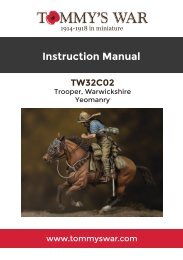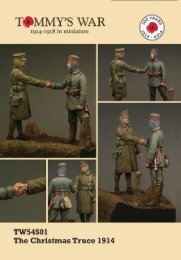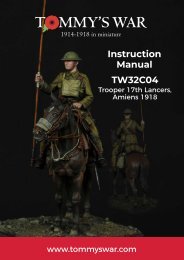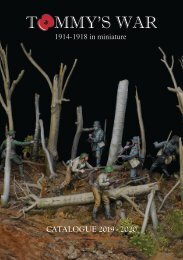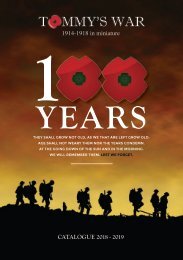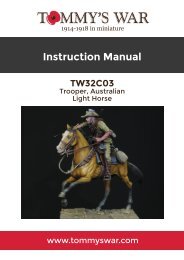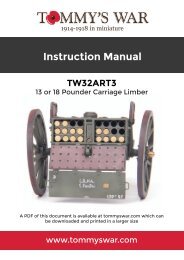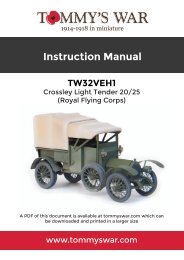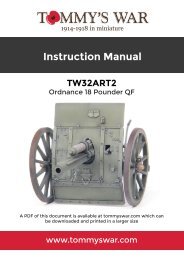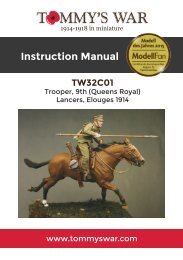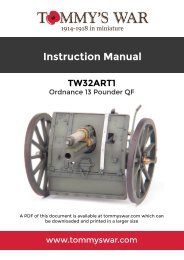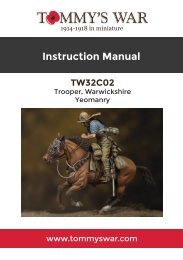Tommy's War painting instructions for British World War One uniform
Tommy's War is the leading producer of World War One model figurines. The range covers Britain and her Empire, the USA, Germany and her allies. In this painting guide Alex Long gives detailed instructions on using Vallejo paints to get outstanding results.
Tommy's War is the leading producer of World War One model figurines. The range covers Britain and her Empire, the USA, Germany and her allies. In this painting guide Alex Long gives detailed instructions on using Vallejo paints to get outstanding results.
You also want an ePaper? Increase the reach of your titles
YUMPU automatically turns print PDFs into web optimized ePapers that Google loves.
Drilling the Figure<br />
I always drill a small hole into the foot of the figure<br />
and superglue a small piece of wire. This gives me<br />
something to anchor the figure while <strong>painting</strong> but<br />
also fits it into the base securely when it’s<br />
completed.<br />
Ready to Go<br />
Once all the parts are fitted check your model, if<br />
there are any small gaps fill with a putty and make<br />
sure you’re happy with the finish. Be<strong>for</strong>e applying<br />
a basecoat wash the model thoroughly in warm<br />
soapy water.<br />
It sounds like a lot, but getting a great finish really<br />
does start at the preparation.<br />
Paint and Colour<br />
If elements of the clean-up cause some anxiety, then<br />
that’s nothing compared to paint and colour choice<br />
and is easily the subject I get the most emails about.<br />
There is a huge amount of paint choice. In this guide<br />
Alex references Vallejo, which is great as it’s one of<br />
the easiest paint brands to get. Vallejo is an acrylic<br />
paint which is the most popular paint type used<br />
at the moment and there are a plethora of other<br />
brands such as AK Interactive, Andrea, Ammo, Scale<br />
75, Nocturna, Army Painter and Citadel (Games<br />
Workshop).<br />
This isn’t even the full list, and doesn’t even cover all<br />
the paint sets that include everything from <strong>painting</strong><br />
flesh to a certain type of RAF aircraft.<br />
It’s no wonder modellers are confused, it’s baffling.<br />
The trick is to not get sucked into the marketing,<br />
certainly at a basic level you won’t find too much<br />
difference between the manufacturers, don’t fall <strong>for</strong><br />
thinking you have to buy a complete set, try<br />
different paints and see which you prefer. I like Andrea<br />
<strong>for</strong> it’s matt finish. Some people like Scale 75<br />
but I find it hard to get out of the dropper bottles.<br />
In-short they are all good paints and you can’t really<br />
go too wrong.<br />
The second part of this is uni<strong>for</strong>m colour, on this my<br />
advice is simple, don’t worry too mucn about it. Yes,<br />
that’s counter to everything a modeller stands <strong>for</strong><br />
but it’s true.<br />
There are two books on <strong>World</strong> <strong>War</strong> <strong>One</strong> uni<strong>for</strong>m<br />
references by Chris Pollendine, Campaign 1914 and<br />
Campaign 1915. These books show original <strong>World</strong><br />
<strong>War</strong> <strong>One</strong> <strong>British</strong> uni<strong>for</strong>m and equipment and I spoke<br />
to Chris some time ago on colour.<br />
Chris explained to me that in all the years of<br />
collecting original uni<strong>for</strong>m he’d seen a huge variety<br />
of shades and colours, from mustard brown to dark<br />
green there wasn’t one single shade that<br />
represented what he had seen.<br />
When you think that between 1914 and 1918 the<br />
<strong>British</strong> were producing millions of pieces of clothing<br />
each year in mills in Britain and Ireland and as far<br />
away as Canada and the US. There were no colour<br />
swatches to reference, no easy communication to<br />
ensure a shade was right and very little quality<br />
control.<br />
However, as modellers, it’s important that th<br />
colour looks correct, so my advice would be to check<br />
online <strong>for</strong> original pieces of uni<strong>for</strong>m and match to<br />
that, alternatively Chris’s books are a great source of<br />
in<strong>for</strong>mation.<br />
I know it’s not everyone’s cup of tea, but Facebook<br />
has some fantastic groups dedicated to uni<strong>for</strong>ms<br />
and I find those incredibly helpful.<br />
Failing all of that, I have worked with the paint<br />
manufacturer Lifecolor and we developed a set of<br />
<strong>World</strong> <strong>War</strong> <strong>One</strong> uni<strong>for</strong>m colour which you can use<br />
‘from the pot’ if you wish.<br />
And finally<br />
My major piece of advice is to enjoy what you’re<br />
doing. The best painters didn’t become great<br />
overnight and while they have considerable<br />
talent they also work hard at their craft.<br />
Painting takes patience and it takes practice.<br />
We’re <strong>for</strong>tunate in these times that there is a<br />
wealth of knowledge online and take your time<br />
to absorb that teaching but also make time to<br />
paint.<br />
I spend a lot of time watching tutorials on<br />
outube, it really is a fantastic resource and there<br />
aren’t many modelling topics you can’t find on<br />
there.<br />
But don’t be discouraged if your work doesn’t<br />
look like those winning artists, enjoy the hobby<br />
<strong>for</strong> what it is <strong>for</strong> you.<br />
Have fun and keep smiling!<br />
www.tommyswar.com<br />
3





